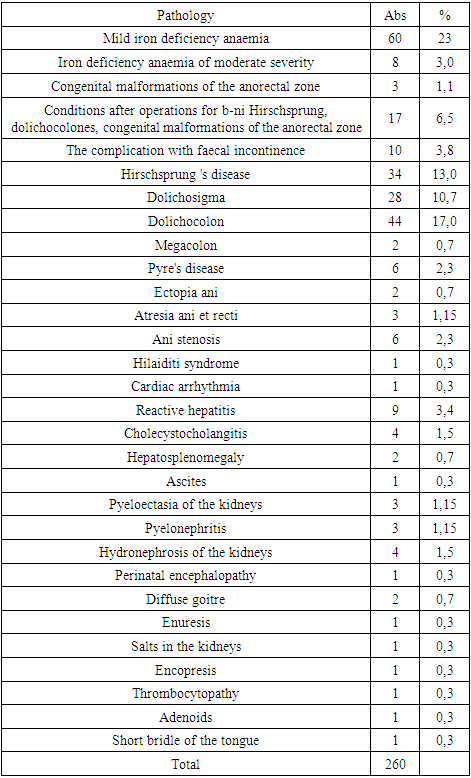-
Paper Information
- Next Paper
- Previous Paper
- Paper Submission
-
Journal Information
- About This Journal
- Editorial Board
- Current Issue
- Archive
- Author Guidelines
- Contact Us
American Journal of Medicine and Medical Sciences
p-ISSN: 2165-901X e-ISSN: 2165-9036
2022; 12(9): 908-911
doi:10.5923/j.ajmms.20221209.12
Received: Aug. 18, 2022; Accepted: Aug. 31, 2022; Published: Sep. 15, 2022

Functional Constipation in Children
Sh. I. Navruzova1, D. R. Khamraeva2, M. U. Ergasheva1, S. H. Rasulova1
1Department of Pediatrics, Bukhara State Medical Institute, Bukhara City, Republic of Uzbekistan
2Department of Propaedeurtics of Childhood Diseases, Bukhara State Medical Institute, Bukhara, Republic of Uzbekistan
Correspondence to: Sh. I. Navruzova, Department of Pediatrics, Bukhara State Medical Institute, Bukhara City, Republic of Uzbekistan.
| Email: |  |
Copyright © 2022 The Author(s). Published by Scientific & Academic Publishing.
This work is licensed under the Creative Commons Attribution International License (CC BY).
http://creativecommons.org/licenses/by/4.0/

Constipation is a common problem in childhood. In most patients, constipation is of a functional nature. The authors studied the frequency of hospitalization of sick children with diseases of the gastrointestinal tract in the department of gastroenterology and pediatric surgery of the Bukhara Regional Children's Multidisciplinary Medical Center in the periods from 2018 to 2020. The study revealed that when studying the regional features of the course of constipation in children, functional constipation prevails by origin – 93.2% of cases, among causal factors, the highest frequency is represented by psychosocial maladaptation and autonomic dysfunction syndrome, according to the clinical course 48.5% of all chronic constipation, among hospitalized patients subcompensated.
Keywords: Constipation, Functional pathology, Gastrointestinal tract, Children
Cite this paper: Sh. I. Navruzova, D. R. Khamraeva, M. U. Ergasheva, S. H. Rasulova, Functional Constipation in Children, American Journal of Medicine and Medical Sciences, Vol. 12 No. 9, 2022, pp. 908-911. doi: 10.5923/j.ajmms.20221209.12.
Article Outline
1. Introduction
- Constipation in children is very common, with a reported frequency of up to 30% [1]. The vast majority (96%) of cases are due to functional causes [2]. Organic causes of constipation are uncommon and most can be ruled out clinically. They include the following: Hirschsprung disease, hypothyroidism, hypercalcaemia, spina bifida/spina bifida occulta and medications that slow down intestinal motility.The Rome IV diagnostic criteria require ≥ 2 of the following, occurring at least once a week for a minimum of one month: ≤ 2 defecations per week; ≥ 1 episode of faecal incontinence a week; retentive posturing; painful or hard bowel movements; large faecal mass in the rectum; and/or large-diameter stools that can obstruct the toilet. However, infrequent stooling in a thriving, fully breastfed baby is not considered constipation and requires only reassurance [3]. Paediatricians and other child care providers manage a large number of children with constipation, a recurrent medical problem that is frustrating to patients, their caregivers, and the health care providers themselves. Most often constipation in children is functional in nature, and only a very small percentage of patients have an organic cause for it. In this review, we discuss the epidemiology, causes, evaluation, and management of children with functional constipation [4]. Although we give our patients many different modalities to treat constipation (eg, diet changes, behaviour modification, probiotics, medication), there is little evidence to support any of these modalities. We also tend to order unnecessary tests during the diagnostic process. This article tries to clarify the diagnostic process and provide a clear treatment path to be used for functional constipation [5].
2. The Purpose of the Research
- The purpose of scientific work was to study the frequency of functional constipation in children, a study was conducted to study the frequency of hospitalization of sick children with diseases of the gastrointestinal tract (gastrointestinal tract) in the department of gastroenterology and pediatric surgery of the Bukhara Regional Children's Multidisciplinary Medical Center in the periods from 2018 to 2020.
3. Materials and Methods
- The analysis showed that during the studied period 43,012 sick children were hospitalized in Bukhara Regional Children's Multidisciplinary Medical Center, of which 8.71% were sick children with gastrointestinal diseases (3745 patients). Among all sick children with gastrointestinal diseases (3745), functional constipation accounted for -7.87% (295 patients).A retrospective analysis of 3745 case histories of children who received inpatient treatment in the departments of gastroenterology and surgery of the Bukhara Regional Children's Multidisciplinary Medical Center from 2018 to 2020 for diseases of the gastrointestinal tract was carried out. During the analysis, 295 case histories of sick children with chronic constipation were selected.
4. Research Results
- The results of the study showed that the total number of patients hospitalized in Bukhara Regional Children's Multidisciplinary Medical Center for 3 years amounted to 43012 patients, in 2018 – 12540 (29.2%), in 2019 – 14024 (32.6%) and 2020 – 16448 (38.2%).Hospitalization of children for gastrointestinal diseases during the studied period was 3745 (8.7%), in 2018 – 1021 (27.3%), in 2019 – 1246 (33.3%) and 2020 – 1478 (39.4%), respectively, which indicates an increase in gastroenterological morbidity over 3 years (Figure 1).
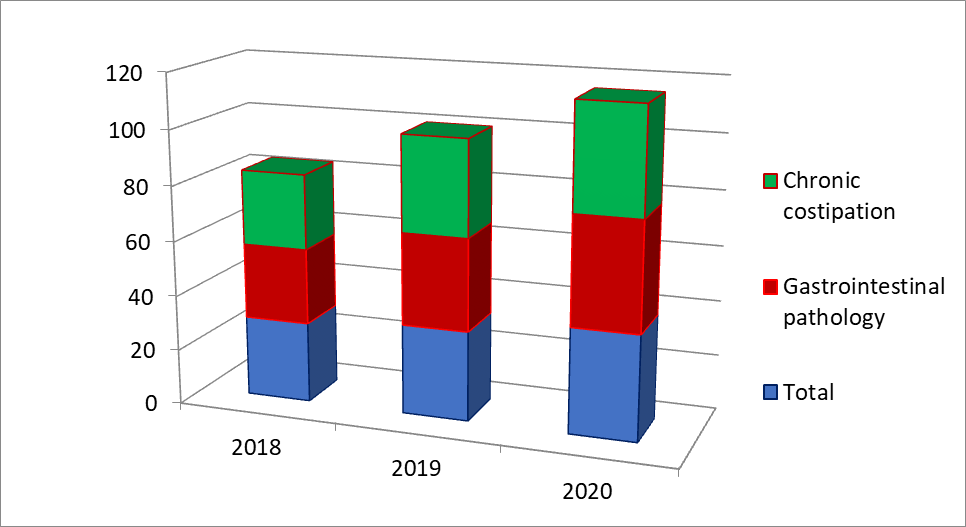 | Figure 1. Frequency of hospitalization of sick children with gastrointestinal diseases |
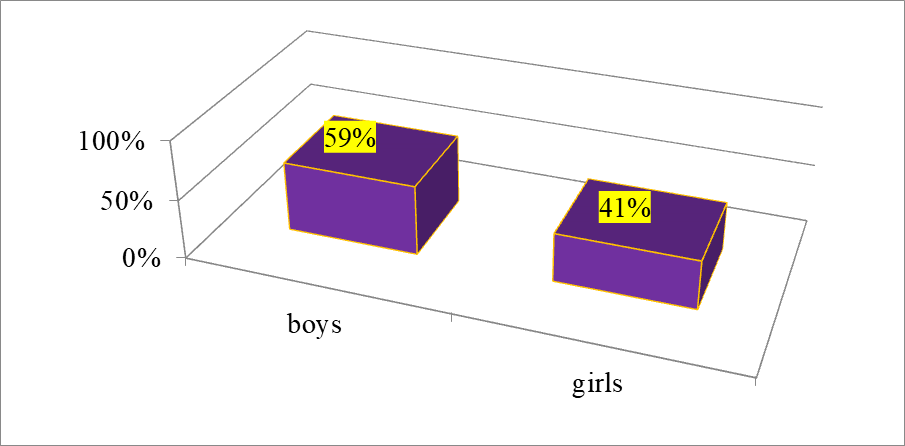 | Figure 2. Distribution of constipated patients by gender |
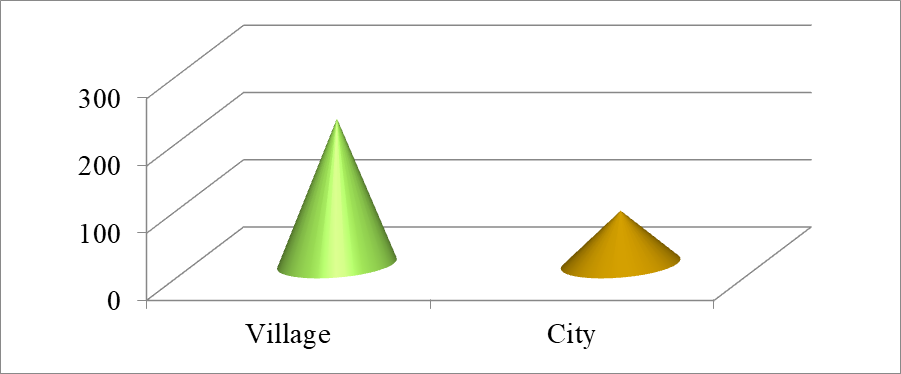 | Figure 3. Distribution of examined patients by place of residence |
 | Figure 4. The nature of constipation in the examined sick children |
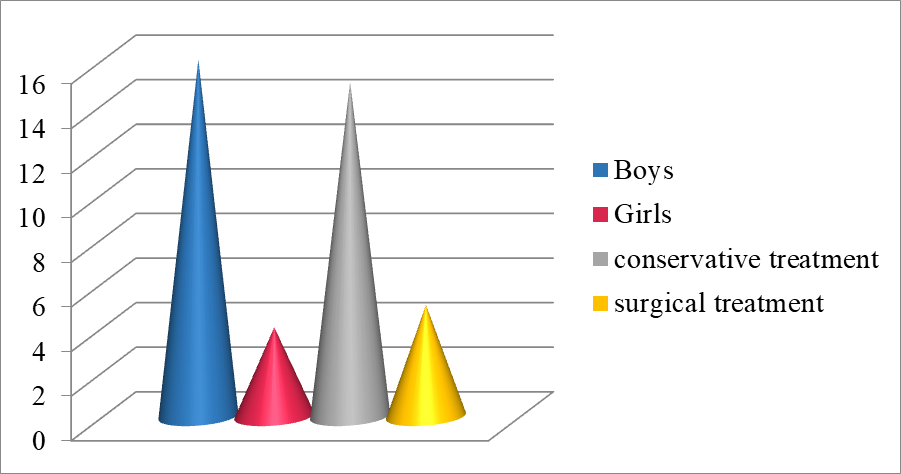 | Figure 5. Gender differences in the frequency of constipation depending on the type of treatment |
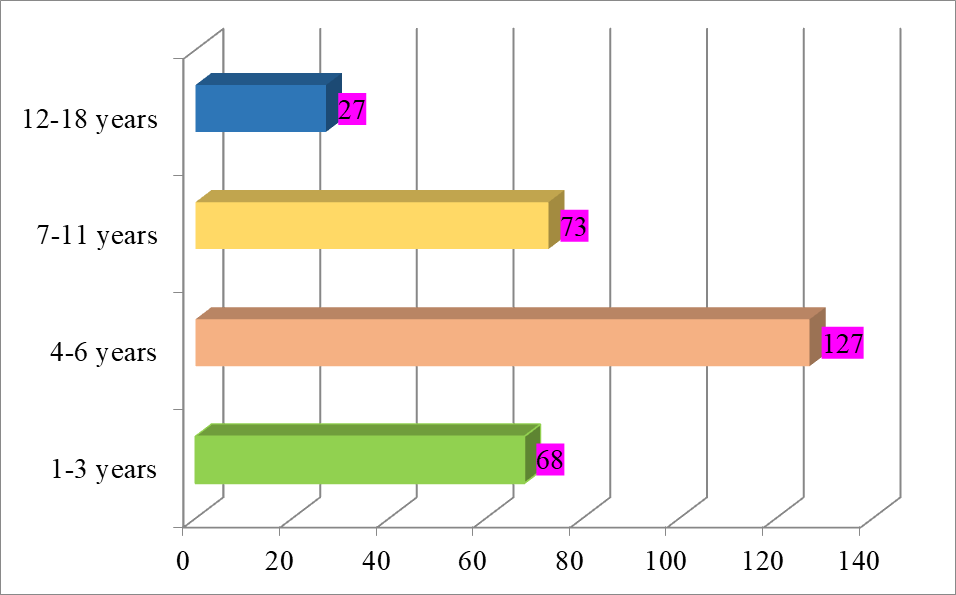 | Figure 6. Age category of patients with constipation |
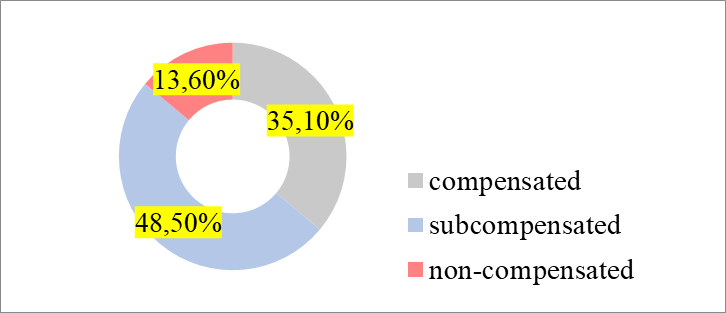 | Figure 7. Clinical stage of constipation in the examined children |
|
5. Conclusions
- All this confirms the importance of preventive measures to prevent chronic constipation in children at risk. The conditions for the effectiveness of constipation treatment and improvement of the patient's quality of life are the interaction of the doctor and the patient in choosing the timing of surgical correction suitable for each individual child with Hirschsprung's disease, as well as the optimal management tactics for functional constipation.
ACKNOWLEDGEMENTS
- The authors acknowledge the immense help received from the scholars whose articles are cited and included in references to this manuscript. The authors are also grateful to the authors/ editors/publishers of all those articles, journals and books from where the literature for this article has been reviewed and discussed.In addition, the authors express gratitude to the head and the scientific community of the Bukhara State Medical Institute for their assistance in carrying out this research work.
Conflicts of Interest
- The authors report no conflicts of interest.
Funding Statement
- Source of funding is nil.
 Abstract
Abstract Reference
Reference Full-Text PDF
Full-Text PDF Full-text HTML
Full-text HTML